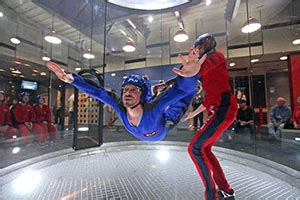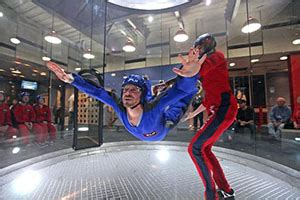Table of Contents
Curious about the weight limit for indoor skydiving? Discover the maximum weight allowed for this thrilling activity and find out if you can experience the sensation of freefalling in a controlled environment. Get all the information you need to make your indoor skydiving adventure a reality.
Have you ever dreamt of flying through the air like a bird, defying gravity and experiencing an adrenaline rush like no other? Well, indoor skydiving might just be the answer to your wildest dreams! But before you take the leap into this thrilling activity, it’s essential to know about the weight limit that comes with it. So, let’s dive right in and find out what the weight limit for indoor skydiving is, and how it can impact your experience.
Introduction
Indoor skydiving is an exhilarating and thrilling activity that allows individuals to experience the sensation of freefall without the need for an airplane. This simulated skydiving experience takes place in a vertical wind tunnel, where participants can float on a cushion of air. While this activity is accessible to most people, there are weight restrictions in place to ensure safety for all participants. In this article, we will explore the weight limit for indoor skydiving and provide essential information for those interested in trying this unique adventure.
Understanding Indoor Skydiving
Before discussing the weight limit for indoor skydiving, it is important to understand how the activity works. In an indoor skydiving facility, a vertical wind tunnel generates a powerful upward airflow. Participants wear a specially designed jumpsuit and helmet to create stability and protection during the experience. The wind speed within the tunnel is carefully controlled to simulate the feeling of freefall. This controlled environment allows individuals to experience the thrill of skydiving without the risks associated with traditional outdoor skydiving.
The Importance of Weight Restrictions
Weight restrictions for indoor skydiving are put in place to ensure the safety of all participants. The wind speed generated in the vertical wind tunnel is adjusted based on the individual’s weight, allowing for an optimal flight experience. If a participant exceeds the weight limit, the wind speed may not be sufficient to support their body, leading to an unsafe and potentially uncomfortable experience. Therefore, it is crucial to adhere to these weight restrictions to guarantee a safe and enjoyable indoor skydiving adventure.
Typical Weight Limit Range
The weight limit for indoor skydiving can vary depending on the specific facility. However, as a general guideline, most indoor skydiving centers have a weight limit range of 250 to 300 pounds (113 to 136 kilograms). It is important to note that these limits may also be influenced by height and body proportions. Some facilities may have additional restrictions based on the participant’s size and physical capabilities. To ensure accuracy, it is always recommended to check with the specific facility beforehand to confirm their weight limit requirements.
Reasons Behind Weight Restrictions
There are several reasons why weight restrictions exist in indoor skydiving. Firstly, the wind speed within the vertical wind tunnel needs to be adjusted according to the participant’s weight to provide adequate lift and stability. Exceeding the weight limit may result in insufficient lift, making it difficult to maintain a stable flying position. Additionally, the wind speed needs to be carefully calibrated to ensure participant safety. If someone significantly exceeds the weight limit, the wind speed may become too strong, potentially causing discomfort or injury.
Considerations for Safety
Indoor skydiving facilities prioritize the safety of their participants above all else. While weight restrictions are in place to maintain safety, other factors are also considered. These may include age, physical fitness, and any medical conditions that could affect the individual’s ability to participate safely. It is essential to provide accurate information about your health and physical condition when making a reservation or signing up for an indoor skydiving experience. This ensures that the facility can assess any potential risks and make appropriate accommodations.
Alternative Options
If you exceed the weight limit for indoor skydiving or have any other limitations that prevent you from participating, there are alternative options to still enjoy the thrill of simulated skydiving. Some facilities offer tandem flights, where an experienced instructor accompanies you during the experience, providing additional support and guidance. Additionally, you can always enjoy the excitement as a spectator and cheer on your friends or family who are participating in indoor skydiving.
Conclusion
Indoor skydiving is an incredible adventure that allows individuals to experience the sensation of freefall in a controlled environment. While weight restrictions exist, they are in place to ensure the safety and enjoyment of all participants. By adhering to these limits, following facility guidelines, and considering alternative options if necessary, anyone can have the opportunity to enjoy the thrilling experience of indoor skydiving. So, if you meet the weight requirements, don’t hesitate to take the leap and embark on this unforgettable journey!
Weight Limit for Indoor Skydiving – User Instructions
Welcome to our user instructions guide on the weight limit for indoor skydiving. Please read the following information carefully to ensure a safe and enjoyable experience.
Understanding the Weight Limit
The weight limit for indoor skydiving refers to the maximum weight at which an individual can safely participate in this activity. It is determined by factors such as equipment capability, instructor guidance, and safety regulations.
Safety Precautions
Before participating in indoor skydiving, it is crucial to adhere to the weight limit restrictions for your own safety and the safety of others. Exceeding the weight limit can compromise the stability of the wind tunnel and make it challenging for instructors to manage the session effectively.
Why Weight Limit Matters
a) Equipment: The wind tunnel is designed to handle a certain amount of air pressure, and exceeding the weight limit can strain the system and compromise its functionality.
b) Instructor Support: Instructors need to ensure the safety of all participants, and exceeding the weight limit can make it difficult for them to manage and control the session effectively.
c) Balance and Stability: Maintaining stability inside the wind tunnel is crucial for a safe and enjoyable experience. The weight limit ensures proper balance and reduces the risk of accidents.
Weight Limit Guidelines
a) Minimum Weight Limit: There is typically a minimum weight limit for indoor skydiving to ensure that participants have enough mass to stabilize and control their movements effectively. This limit is usually around 40-50 pounds (18-23 kilograms).
b) Maximum Weight Limit: The maximum weight limit varies depending on the specific indoor skydiving facility and equipment manufacturer. Generally, it ranges between 230-300 pounds (104-136 kilograms).
Checking Weight Limit Requirements
Before planning an indoor skydiving session, it is essential to check with the facility you intend to visit regarding their specific weight limit guidelines. Reliable facilities provide this information on their websites or contact them directly for accurate details.
Important Considerations
a) Health Conditions: It is crucial to consider any physical restrictions or health conditions that may affect your ability to safely participate in indoor skydiving, even within the weight limit guidelines.
b) Comfortable Attire: Wear comfortable clothing that allows for free movement and fits within the facility’s safety guidelines. Loose items such as jewelry, watches, or loose-fitting garments should be removed.
Conclusion
Understanding and adhering to the weight limit for indoor skydiving is vital in ensuring a safe and enjoyable experience for yourself and others. Remember to consult the specific facility you plan to visit, follow all safety guidelines, and have a fantastic time soaring through the air in a controlled and thrilling environment.
Instructions for Indoor Skydiving Weight Limit:
-
Understanding the weight limit:
- Indoor skydiving is an exhilarating activity that simulates the experience of freefalling in a vertical wind tunnel.
- It is important to note that there are weight restrictions in place to ensure the safety and enjoyment of all participants.
- The weight limit for indoor skydiving varies depending on the specific facility and their equipment capabilities.
-
Finding out the weight limit:
- Before planning your indoor skydiving adventure, it is crucial to check with the facility you wish to visit about their weight restrictions.
- Most indoor skydiving centers provide this information on their website or over the phone.
- They may have different weight limits for various flight packages or age groups, so it is essential to inquire about any specific requirements.
-
Reasons for weight restrictions:
- Weight restrictions are in place due to the limitations of the wind tunnel’s design and the safety considerations involved.
- The wind speed and airflow within the tunnel need to be adjusted according to the participant’s weight to ensure proper stability and control during the flight.
- Exceeding the weight limit can compromise the participant’s safety and the overall experience.
-
Alternative options if above weight limit:
- If you find that you exceed the weight limit for indoor skydiving, do not be disheartened!
- Many facilities offer alternative activities such as virtual reality skydiving experiences or observation decks where you can still enjoy the thrill of watching others fly.
- Some centers may also provide weight loss programs or special training sessions to help individuals reach the required weight limit for future flights.
-
Following instructions and guidelines:
- It is essential to respect and adhere to the weight restrictions set by each indoor skydiving facility.
- These limitations are in place to ensure a safe and enjoyable experience for all participants.
- Always follow the instructions provided by the staff, wear the recommended attire, and listen carefully to the pre-flight briefing to maximize your enjoyment and safety during the activity.
Remember, indoor skydiving is an exciting adventure, and by understanding and respecting the weight limits, you can have a thrilling experience while prioritizing your safety and the safety of others.
Thank you for taking the time to visit our blog and learn more about the weight limit for indoor skydiving. We hope that this article has provided you with the information you were seeking and has given you a better understanding of the requirements and limitations associated with this thrilling activity.
Indoor skydiving, also known as vertical wind tunnel flying, is a popular recreational activity that allows individuals to experience the sensation of freefalling without actually jumping from an airplane. While it is a safe and enjoyable activity for most people, there are certain weight restrictions in place to ensure the safety of both the participants and the instructors.
Most indoor skydiving facilities have a weight limit of around 250-300 pounds (113-136 kilograms) for participants. This limit is primarily based on the capabilities of the wind tunnel and the strength of the air flow generated within it. Exceeding this weight limit can affect the stability and control of the participant during the flight, potentially compromising their safety. Therefore, it is important to adhere to these weight restrictions to ensure a smooth and secure experience.
If you are above the weight limit for indoor skydiving, don’t be disheartened! There are still other options available for you to experience the thrill of skydiving. Tandem skydiving, for example, allows individuals of higher weights to skydive with the assistance of a trained instructor. This involves being securely harnessed to the instructor who will handle all aspects of the jump, ensuring a safe and enjoyable experience for both parties.
In conclusion, understanding the weight limit for indoor skydiving is crucial for the safety and enjoyment of all participants. By adhering to these restrictions, you can have a memorable and exhilarating experience while minimizing any potential risks. If you find yourself above the weight limit, consider exploring alternative options such as tandem skydiving. Remember to always prioritize safety and have fun exploring the world of skydiving!
Thank you again for visiting our blog, and we hope to see you soon in the thrilling world of indoor skydiving!
.
What is the weight limit for indoor skydiving?
1. Is there a weight restriction for indoor skydiving?
2. What is the maximum weight allowed for indoor skydiving?
3. Are there any weight limitations for indoor skydiving?
4. Can overweight individuals participate in indoor skydiving?
Answer:
- Yes, there is a weight restriction for indoor skydiving. The weight limit varies depending on the specific facility and equipment used. It is important to check with the indoor skydiving center beforehand to confirm their weight restrictions.
- The maximum weight allowed for indoor skydiving can range from around 250 lbs (113 kg) to 300 lbs (136 kg) in most cases. This weight limit is set to ensure the safety of the participants and the proper functioning of the equipment.
- Some indoor skydiving facilities may have weight limitations due to the capacity and capabilities of their wind tunnels. It is essential to follow these restrictions to ensure a safe and enjoyable experience for everyone.
- Overweight individuals can usually participate in indoor skydiving as long as they meet the weight requirements set by the facility. However, it is recommended to consult with the indoor skydiving center to discuss any concerns or limitations that may apply.






